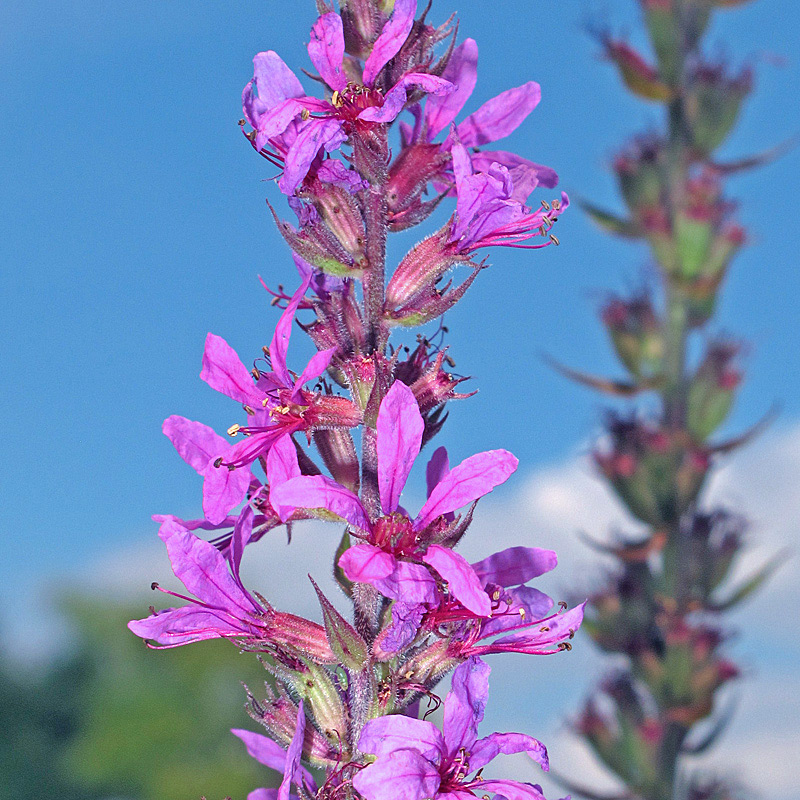Botanical name
Lythrum salicaria L.
Family
Lythraceae
Common name
Purple loosestrife, Spiked loosestrife
Information about the plant
The purple loosestrife is almost cosmopolitan, growing in Europe, Asia, and North Africa, and was probably introduced to America. It prefers damp, watery places, and in Germany, it can be found on the banks of streams, ponds and lakes, as well as in damp ditches and meadows, and fens.
The name “loosestrife” is derived from the willow-like shape of the leaves, which is also expressed in the species epithet salicaria (Latin salix, salicis = willow). The term “blood-”, in the German name, refers to the blue-purple color of the flowers. Linné was reminded of the blood of the purple snail (gr. = lythron) by the color of the flowers.
The purple loosestrife is a perennial herbaceous plant that can grow up to 1 m tall with a four-edged stem. The elongated elliptical leaves near the ground are opposite, while the upper, narrow lanceolate leaves are alternate. The numerous purple-red flowers form an approx. 20 cm long, densely whorled spike. The flower consists of an inner and an outer calyx and has six petals. It also features six short and six long stamens. The fruits are two-lobed capsules. It flowers from June to September.
Medicinally used parts of plants (herbal drug)
The dried flowering twig tips are used, consisting of leaves, flowers, and stems (purple loosestrife - Lythri herba).
The commercially available drug comes from wild collections in Eastern European countries.
Constituents of the herbal drug
Purple loosestrife contains tannins, flavonoids and phenolcarboxylic acids, as well as anthocyanidins (colorants in the flower)
Quality of the drug
The quality of purple loosestrife (Lythri herba) is specified in the European Pharmacopoeia (Ph. Eur.).
Medical applications
Recognised medical use
Purple loosestrife has not yet been evaluated by the HMPC and ESCOP.
The drug is used in folk medicine, mainly in France, to treat diarrhea, as are other “tannin drugs” (e.g. lady's mantle herb, agrimony, goose cinquefoil). The antidiarrheal effect of a liquid extract from the fresh plant has been confirmed. It is also popularly used as an astringent for inflammation of the gastric mucosa.
Traditional use
Purple loosestrife has not yet been classified as a traditional medicinal product.
Herbal drug preparations in finished dosage forms
Cut purple loosestrife for tea preparation.
Dosage
Finished medicinal products: not applicable
Tea: drink a cup of purple loosestrife tea several times a day between meals.
Preparation of a tea
Pour approx. 150 mL of boiling water over 2 to 5 g of finely cut purple loosestrife and strain after 10 minutes.
Notes
There is no available evidence on the use of purple loosestrife during pregnancy and lactation or for use in children and adolescents under the age of 18; therefore, its use is not recommended.
Side effects
Irritable stomach symptoms can be exacerbated.
Interactions
Not known.
References
Herbal drug monographs
Not known.
Further literature
Commentary on the European Pharmacopoeia (Purple loosestrife, No. 1537)


